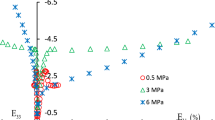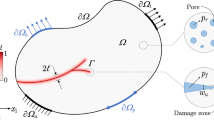Abstract
Many models of damage or cracking of isotropic solids consider a single damage/crack density variable. Based on both continuum damage mechanics (CDM) and effective medium theory (EMT), we model the impact of isotropic damage in the form of microcracks on the elastic properties of an isotropic solid. For each approach, we consider the complete tensorial description of the elastic moduli involving two damage/crack density variables \(D_{1}\) and \(D_{2}\), or \(\alpha\) and \(\beta\); and possible scalar approximations involving a single variable (with either \(D_{2}\) = 0, or \(\beta\) = 0). We assess the accuracy of scalar approximations commonly employed for each approach against laboratory measurements of ultrasonic wave velocities and density obtained on a dry and isotropic specimen of thermally cracked Carrara Marble (CM) subjected to an increasing confining pressure up to 50 MPa. Overall, this laboratory dataset and the CDM and EMT modelling and inversion results reported here suggest that: (i) irreversible thermal cracking and microcrack opening occur after heating and sudden cooling of the CM specimen, whereas reversible and progressive microcracks’ closure occurs with increasing confining pressure; (ii) tensorial damage/cracking models involving either two damage variables (CDM) or two crack density variables (EMT) fit equally well and virtually perfectly the laboratory data for any confining pressure tested; (iii) single scalar approximation models commonly used in CDM or the EMT models give comparable results to their complete tensorial counterparts, which is particularly true for the CDM approach; (iv) single scalar approximations derived from the CDM approach, and assuming a constant Poisson’s ratio of the cracked rock, reproduces all the elastic moduli more accurately than the corresponding scalar approximation derived from the EMT approach, where a constant ratio of Young’s modulus to Poisson’s ratio is assumed instead; and (v) it is more reliable to use a tensorial rather than a scalar description of the effect of reversible microcrack closure with pressure on all elastic parameters, including Poisson’s ratio. If the impact of reversible microcrack closure is accounted for, then a single scalar description of irreversible thermal damage with the CDM approach is remarkably accurate.





Similar content being viewed by others
References
Ahn E, Kim H, Sim SH, Shin S, Shin M (2017) Principles and applications of ultrasonic-based nondestructive methods for self-healing in cementitious materials. Materials 10:278. https://doi.org/10.3390/ma10030278
Audoin B, Baste S (1994) Ultrasonic evaluation of stiffness tensor changes and associated anisotropic damage in a ceramic matrix composite. J Appl Mech 61:309
Birch F (1960) The velocity of compressional waves in rocks to 10 kilobars: 1. J Geophys Res 65:1083
Brantut N (2015) Time-dependent recovery of microcrack damage and seismic wave speeds in deformed limestone. J Geophys Res pp 8088–8109, https://doi.org/10.1002/2015JB012324
Bristow J (1960) Microcracks, and the static and dynamic elastic constants of annealed and heavily cold-worked metals. Br J Appl Phys 11:81
Case E (1984) The effect of microcracking upon the Poissons ratio for brittle materials. J Mater Sci 19:3702
Castellano A, Fraddosio A, Piccioni M (2017) Ultrasonic goniometric immersion tests for the characterization of fatigue post-lvi damage induced anisotropy superimposed to the constitutive anisotropy of polymer composites. Compos B 116:122
Cauvin A, Testa R (1999a) Damage mechanics basic variables in continuum theories. Int J Solids Struct 36:747–761
Cauvin A, Testa R (1999b) Elastoplastic material with isotropic damage. Int J Solids Struct 36:727–746
Curie P (1894) Sur la symétrie dans les phénomènes physiques, symétrie dun champ électrique et dun champ magnétique. Journal de Physique Théorique et Appliquée 3:393–415
Eshelby JD (1957) The determination of the elastic field of an ellipsoidal inclusion, and related problems. Proc R Soc London Ser A 241(1226):376. https://doi.org/10.1098/rspa.1957.0133
Eslami J, Grgic D, Hoxha D (2010) Estimation of the damage of a porous limestone from continuous (p- and s-) wave velocity measurements under uniaxial loading and different hydrous conditions. Geophys J Int 183:1362–1375. https://doi.org/10.1111/j.1365-246X.2010.04801.x
Grechka V, Kachanov M (2006) Effective elasticity of rocks with closely spaced and intersecting cracks. Geophysics 71:D85–D91
Helbig K (1994) Foundations of anisotropy for exploration seismics. Pergamon
Hufenbach W, Böhm R, Langkamp A, Kroll L, Ritsche T (2006) Ultrasonic evaluation of anisotropic damage in multiaxially textile reinforced themoplastic hybrid composites made by hybrid yarns. Mech Compos Mat 42:151
Hughes I, Hase T (2010) Measurements and their uncertainties A Practical Guide to Modern Error Analysis. Oxford
Kachanov M (1980) Continuum model of medium with cracks. J Eng Mech Div 106:1039–1051
Kachanov M (1993) Elastic solids with many cracks and related problems. Adv Appl Mech 30:259–445
Kaproth B, Marone C (2014) Evolution of elastic wave speed during shear-induced damage and healing within laboratory fault zones. J Geophys Res: Solid Earth pp 4821–4840, https://doi.org/10.1002/2014JB011051
Lemaitre J (1996) A course on damage mechanics. Springer-Verlag, New York
Li LC, Tang CA, Li G, Wang SY, Liang ZZ, Zhang YB (2012) Numerical simulation of 3d hydraulic fracturing based on an improved flow-stress-damage model and a parallel fem technique. Rock Mech Rock Eng 45(5):801–818
Mondal S, Olsen-Kettle L, Gross L (2019) Simulating damage evolution and fracture propagation in sandstone containing a preexisting 3-d surface flaw under uniaxial compression. Int J Numer Anal Meth Geomech 43(7):1448–1466
Mondal S, Olsen-Kettle L, Gross L (2020) Regularization of continuum damage mechanics models for 3-d brittle materials using implicit gradient enhancement. Comput Geotech 122:103505
Murakami S (2012) Continuum damage mechanics A Continuum Mechanics Approach to the Analysis of Damage and Fracture. Springer, New York
Olsen-Kettle L (2018a) Bridging the macro to mesoscale: Evaluating the fourth order anisotropic damage tensor parameters from ultrasound measurements of an isotropic solid under triaxial stress loading. Int J Damage Mech. https://doi.org/10.1177/1056789518757293
Olsen-Kettle L (2018b) Quantifying the orthotropic damage tensor for composites undergoing damage-induced anisotropy using ultrasonic investigations, manuscript submitted for publication
Olsen-Kettle L (2018c) Using ultrasonic investigations to develop anisotropic damage models for initially transverse isotropic materials undergoing damage to remain transverse isotropic. I J Solids Struct 138:155–165. https://doi.org/10.1016/j.ijsolstr.2018.01.007
Ouarabi M, Antonaci P, Boubenider F, Gliozzi A, Scalerandi M (2017) Ultrasonic monitoring of the interaction between cement matrix and alkaline silicate solution in self-healing systems. Materials 10:46. https://doi.org/10.3390/ma10010046
Rasolofosaon P (1998) Stress-induced seismic anisotropy revisited. Revue De LInstitut Francais du Pétrole 53:679–692
Sarout J, Molez L, Guéguen HN (2007) Shale dynamic properties and anisotropy under triaxial loading: experimental and theoretical investigations. Phys Chem Earth 32:896–906. https://doi.org/10.1016/j.pce.2006.01.007
Sarout J, Cazes E, Piane CD, Arena A, Esteban L (2017) Stress-dependent permeability and wave dispersion in tight cracked rocks: Experimental validation of simple effective medium models. J Geophys Res. https://doi.org/10.1002/2017JB014147
Sayers C, Kachanov M (1995) Microcrack-induced elastic wave anisotropy of brittle rocks. J Geophys Res 100(B3):4149–4156
Voigt W (1910) Lehrbuch der kristallphysik. Teubner, Leipzig
Walsh J (1965a) The effect of cracks in rocks on Poissons ratio. J Geophys Res 70:5249
Walsh J (1965b) The effect of cracks on the compressibility of rock. J Geophys Res 70:381
Zhu W, Tang C (2004) Micromechanical model for simulating the fracture process of rock. Rock Mech Rock Eng 37:25–56. https://doi.org/10.1007/s00603-003-0014-z
Zimmerman R (1985) The effect of microcracks on the elastic moduli of brittle materials. J Mater Sci Lett 4:1457
Acknowledgements
This research is supported by the Australian Research Council Discovery Early Career Researcher Award DE140404398. We acknowledge the financial support provided by CSIRO’s Onshore Gas Program through a Strategic Research Fund, and the assistance of the technical officers of CSIRO’s Geomechanics and Geophysics Laboratory: Bruce Maney, Shane Kager, Leigh Kiewiet, Stephen Firns, and David Nguyen.
Author information
Authors and Affiliations
Corresponding author
Ethics declarations
Conflict of interest
The authors declare that they have no conflict of interest.
Additional information
Publisher's Note
Springer Nature remains neutral with regard to jurisdictional claims in published maps and institutional affiliations.
Rights and permissions
About this article
Cite this article
Olsen-Kettle, L., Sarout, J. Assessment of Tensorial and Scalar Damage Models for an Isotropic Thermally Cracked Rock Under Confining Pressure Using Experimental Data: Continuum Damage Mechanics Versus Effective Medium Theory. Rock Mech Rock Eng 55, 505–519 (2022). https://doi.org/10.1007/s00603-021-02693-8
Received:
Accepted:
Published:
Issue Date:
DOI: https://doi.org/10.1007/s00603-021-02693-8




